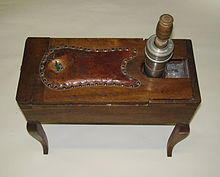Giovanni Alessandro Brambilla
Giovanni Alessandro Brambilla , German Johann Alexander (von) Brambilla (born April 15, 1728 in San Zenone al Po , † July 30, 1800 in Padua ), was an Italian doctor , military surgeon and imperial personal physician.
Life
Giovanni Alessandro Brambilla was first taught by the village priest at his place of birth. In 1752, he enrolled in the medical faculty of the University of Padua , but developed an interest in surgery under the influence of Gerolamo Grazioli and Baldassarre Beretta Della Torre . As early as 1752 he joined the Austrian Hagenbach Infantry Regiment as a junior surgeon. In 1757 he passed the surgical exam in Vienna. In the regiment of Marshal Franz Moritz von Lacy , he gained experience as a military surgeon during the Seven Years' War . In 1764 he was appointed personal surgeon of the heir to the throne Joseph II . As a constant companion of the emperor on his travels, Brambilla was able to exchange professional information with leading surgeons in Italy, France and Russia. In 1778 Brambilla received the title of senior chief surgeon or protosurgeon of the upper class. In the war year 1779 he became superintendent of the military medical service. Brambilla frankly pointed out to Joseph II the deplorable state of the Austrian field medical system and opened the way for the Josephine reform of field medical services.
After years of preparatory work and the union of surgeons with doctors, Brambilla opened the Military Medical School in 1781, which offered practical training in war traumatology, hygiene and epidemiology in a two-year course. On the recommendation of Brambilla, prospective surgeons received grants for further training at European surgical academies. In 1784 he received a title of nobility and the Carpiano estate . On November 7, 1785, Brambilla opened his life's work, a medical and surgical academy, the Josephinum . On February 3, 1786, this Vienna Military Medical Academy , headed by Brambilla as the first director, was granted all the privileges of a university. The academy had 6 chairs (anatomy, pathology, surgical operations, medicine, botany and chemistry, as well as prosecution). In 1789 Brambilla was elected to the Leopoldina Scholars' Academy . Brambilla invented and improved medical instruments and ensured their distribution through a catalog of 600 instruments (Instrumentarium chirurgicum Viennese, 1780).
Brambilla treated Joseph II, who had developed a tubercular fistula, until his death in 1790. After the death of the patron and benefactor and the subsequent decline of the Josephinum, Brambilla withdrew to Pavia in 1795. On July 30, 1800, he died in Padua of gangrenous cystitis.
In 1894 the Brambillagasse in Vienna- Simmering (11th district) was named after him.
Publications
- Storia delle scoperte fisico-medico-anatomico-chirurgiche fatte dagli illustri italiani, three volumes, Milan 1780–82.
- Surgical-practical treatise on phlegmon and its outcomes, 2 volumes, Vienna, Trattner 1775.
- Instrumentarium chirurgicum militare austriacum, Vienna, Schmidt, 1781.
- Instrumentarium Chirurgicum Viennense. Or Wiennerische Chriurgische Instrumentenammlung. MA Schmidt, Vienna 1781.
- Instructions for the professors of the KK Surgical Military Academy, Vienna, Trattner 1784.
- Constitution and statutes of the Josephine Medical-Surgical Academy, including the regulations for promotions to masters and doctors in surgery, Vienna Trattner, 1786.
literature
- Constantin von Wurzbach : Brambilla, Johann Alexander Ritter von . In: Biographisches Lexikon des Kaiserthums Oesterreich . 2nd part. Publishing house of the typographic-literary-artistic establishment (L. C. Zamarski, C. Dittmarsch & Comp.), Vienna 1857, p. 108 f. ( Digitized version ).
- Karl Weiß: Brambilla, Johann Alexander Ritter von . In: Allgemeine Deutsche Biographie (ADB). Volume 3, Duncker & Humblot, Leipzig 1876, p. 233 f.
- Leopold Schönbauer : Brambilla, Johann Alexander Ritter von. In: New German Biography (NDB). Volume 2, Duncker & Humblot, Berlin 1955, ISBN 3-428-00183-4 , p. 514 ( digitized version ).
- Appunti di Storia della Medicina Pavese, Ordine proninciale dei medici chirurghi e degli odontoiatri di Pavia, Bolletino 3/2000
Web links
Individual evidence
- ^ Karl Holubar : Brambilla, Giovanni Alessandro. In: Werner E. Gerabek , Bernhard D. Haage, Gundolf Keil , Wolfgang Wegner (eds.): Enzyklopädie Medizingeschichte. De Gruyter, Berlin / New York 2005, ISBN 3-11-015714-4 , p. 204.
| personal data | |
|---|---|
| SURNAME | Brambilla, Giovanni Alessandro |
| BRIEF DESCRIPTION | Italian doctor and military surgeon |
| DATE OF BIRTH | April 15, 1728 |
| PLACE OF BIRTH | San Zenone al Po , Province of Pavia, Italy |
| DATE OF DEATH | July 30, 1800 |
| Place of death | Padua |

